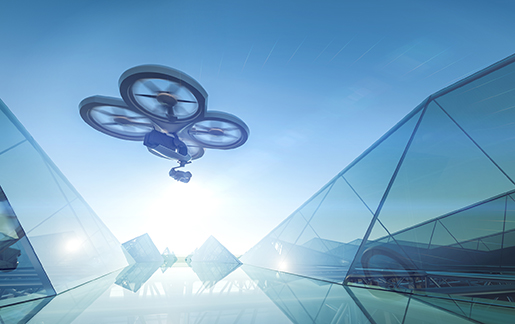 There are a lot of good reasons why uncrewed aerial vehicles (i.e., UAVs or drones) do not fly near, let alone contact, structures such as buildings, trees, or vehicles: it is very dangerous. In addition to environmental variables such as wind and barometric pressure creating difficult flight conditions, a host of technical issues, such as magnetic, electrical, and radio frequency interference, can also negatively impact drone flights.
There are a lot of good reasons why uncrewed aerial vehicles (i.e., UAVs or drones) do not fly near, let alone contact, structures such as buildings, trees, or vehicles: it is very dangerous. In addition to environmental variables such as wind and barometric pressure creating difficult flight conditions, a host of technical issues, such as magnetic, electrical, and radio frequency interference, can also negatively impact drone flights.
For successful operations, UAV pilots need to recognize that a drone is a tool and, like any tool, is best suited for its intended use. No one should fly near, nor try to contact a surface or structure, unless the drone has been designed for that type of use or specific use case. As business use cases and opportunities for drones and other UAVs increase, here are some things for drone service providers (both new and seasoned) to remember when it comes to flying safely.
Location, Direction, and Elevation Are Keys to Success
To fly a drone safely there are three primary indicators that any drone needs to know in real-time in flight: location, or where it is in the world; direction, or where it is headed; and altitude, or how far is it from the ground.
- Location. Typically, the drone uses the onboard Global Positioning Satellite (GPS) receiver to determine its exact spatial location. However, in many industrial locations or environments, such as above-ground storage tanks or large cargo ships, satellite signals may not be fully received and result in degraded or denied GPS coordinates.
- Direction. The magnetic compass onboard the drone is used to find north, which allows the drone to know its heading and directional orientation. However, in some environments, such as near large metal steel objects, compass readings can be inaccurate or unavailable.
- Elevation. Drones, like commercial aircraft, use barometric pressure to determine distance from the ground. However, when in close proximity to structures barometric readings are often skewed or incorrect.
When any of these three information flows to the UAV autopilot fails, either partially or completely, there is potential for loss of control of the aircraft. Degradation or false information and data flowing to the autopilot, navigation controls, motors, or any other subsystem is dangerous.
Solving For Compromised Flight Data
It’s possible to overcome some of these issues by building a Faraday cage or shield around some of the drone’s electronics. A Faraday cage is a grounded metal cover or screen surrounding a piece of equipment to exclude electrostatic and electromagnetic influences. This is particularly helpful, for example, for companies that complete close visual inspection of live powerlines on power transmission towers.
Another more complex solution involves designed and manufactured systems of a robotic arm/rod that protrudes from the drone body past the propellers, with a probe tip that makes physical contact with a surface, known in the robotics world as an end-effector. To enable the system to make physical contact with structures during flight they use a multimodal array of various sensors, an onboard computer, and a set of complex integrations, including a lot of software, to allow automated precision flight control close to structures. These systems flights make 20 or more micro adjustments to the flight per second, impossible for human pilots to replicate.
There is no single solution that is best in all instances or for every potential use case. What is appropriate for one scenario may not be appropriate for another. You should not use a generic drone designed for flying far and fast to fly slow and close to, or come in contact with, structures.
Solving For Environmental Factors
When flying close to structures, in addition to generic compromised flight data that can negatively impact GPS, compass, or barometric pressure information, there are environmental factors that can also have negative effect on flight safety, including:
- Atmospheric/barometric pressure inaccuracies
- Wind and breezes
- Venturi effect, or winds around structures
- Magnetic interference
- Radio-frequency interference, sometimes called electromagnetic interference
Atmospheric/barometric pressure inaccuracies: Atmospheric pressure, also known as barometric pressure, is the pressure of Earth’s atmosphere roughly measured as the difference in air pressure from a sea-level mean. As altitude increases, atmospheric pressure decreases allowing one to calculate the atmospheric pressure at a given altitude. However, barometric inaccuracies occur near structures as both wind and air pressure are disturbed. Temperature and humidity also affect the atmospheric pressure, but temperature and humidity sensors can correct for this. One way to help increase altitude measurement accuracy is with a laser altimeter that measures distance to the ground vs. the barometric altimeter measuring air pressure. Having both a laser and a barometric altimeter sensor is also helpful as it allows for data fusion which heightens the strengths of each data stream while minimizing the weaknesses.
Wind and breezes: Wind can negatively impact drone flights. Drones have to work harder to fly in heavier winds, shortening flight time and battery life, which can negatively impact stability. It is not recommended to fly drones in strong winds especially when you are flying close to structures. Drone pilots can wait for the winds to calm down, or another strategy is to use a system with autonomous flight controls that compensate or even take over flight from the manual input by a pilot on the ground. Several drone manufacturers do this with various levels of success, partly dependent on the physical characteristics of the drone and on wind speed and gusts. For example, flying a drone when there is a constant wind is much easier than one where there are gusts of wind. In some cases, drifting slowly a few feet off course and returning to the planned flight path as the winds slow can be perfectly acceptable. However, a very small deviation from the intended flight path can be dangerous.
Venturi Effect (for wind): Flying close to structures during wind is fraught with even more danger and complexity. The Venturi Effect refers to a change in pressure when fluid enters a constricted area within a pipe. The Venture Effect also applies to air and winds, as when air flows through a confined area it becomes constricted and the velocity increases. For example, there may wind speeds of 5 mph a few meters from the structure but when the wind hits the structure and “whips” around it the wind speed could be 10 or 15 mph.
In addition, winds behave differently around structures than in an open environment. A drone’s propellers can generate turbulence and “push back” from the structure similar to ground-level turbulence. The best way to mitigate for this is with software flight controls, especially precision flight control systems. For example, if the drone is flying based on onboard sensors and computers it can, as discussed earlier, make 20 or more micro adjustments to the flight per second, something that human pilots cannot do.
Magnetic Interference: Electromagnetic interference is any disturbance that negatively impacts an electrical circuit due to electromagnetic induction or electromagnetic radiation. These disturbances, emitted primarily from external sources, can interrupt, obstruct, or otherwise degrade or limit the effectiveness of electronic equipment. Drones crunch a ton of information each second just to stay flying in the best of circumstances. Magnetic interferences can negatively affect the drone’s navigation when it is looking to magnetic north for direction. In addition, disturbance in the Earth’s magnetic field can be caused by solar wind. This is measured as the KP-index.
Mitigating for magnetic interference can be as simple as flying in locations where there are no power lines, mobile phone towers, or structures with Ferrous materials. Even certain rocks with high metal content can be enough to degrade your drones flight performance if you are flying close to them. In addition, there are other mitigation strategies including shielding the drone’s electronics, flying drones that use on onboard sensors and computers allowing for multiple micro adjustments to the flight per second, or a combination of both.
Radio frequency interference: Similar to magnetic and electromagnetic interference, radio-frequency interference occurs when there is a disturbance generated by an external source that affects an electrical circuit by electromagnetic induction, electrostatic coupling, or conduction. The disturbance may degrade the performance of the circuit or even stop it from functioning. Drones are heavily reliant on data from integrated circuits that are part of the accelerometers, inertial measurement units, barometers, magnetometer, autopilots, onboard computers and more. Further, control of the drone often is from the radio controller manually operated by the remote pilot on the ground.
Effects caused by radio-frequency interference can range from an increased error rate to a total loss of data, resulting in a loss of control that can be catastrophic for drones. There is a plethora of both man-made and natural sources that generate changing electrical currents and voltages capable of causing interference in devices. The prevention of radio frequency and electromagnetic interference can be accomplished by shielding (such as a Faraday cage), building in redundancies, using hardened electronic components, enabling autonomous flight without input from a ground controller, and other methods.
Conclusion – The Right tool for the Right Job Enables Safe Flights
Drones are sophisticated electronic devices made up of a complex set of system integrations operating via embedded software. In addition, flight directions are provided to the drone from onboard sensors and computers, an operator on the ground, or both. This set of interdependent functionalities allows for the drone to do amazing things—like almost defying physics.
UAV operators should recognize that drones, and their specific functionalities and capabilities, are best suited for their intended use. Therefore no one should fly a drone near or try to fly it to contact a surface or structure unless the drone has been designed for that type of use or specific use case.
Fly safe, be safe, and have fun.
Robert Dahlstrom is the CEO of Apellix and a member of CompTIA’s Drone Advisory Council.
Want to learn more about flying drones? Check out Drones Standards and Best Practices, created by CompTIA's Drones Advisory Council.

 Add CompTIA to your favorite RSS reader
Add CompTIA to your favorite RSS reader

